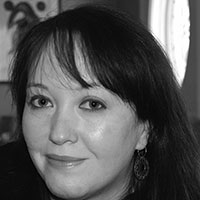Dr. Amber Meadow Adams explores the Haudenosaunee (Iroquois) Creation Story in a lecture
 Dr. Adams’ lecture "The Woman who Seeded the Earth: A Haudenosaunee Ecology" will focus on the Haudenosaunee story about the creation of Earth and the local biome told for thousands of years. Richly detailing the relationships between many of the indigenous plant species now growing on Cornell Plantations’ grounds and humans, the story richly illustrates the breakdown of these relationships during periods of ecological crisis, and the strategies human beings adopt in response. Dr. Adams’ lecture will describe how the strategies — biological, psycho-social, and economic — presented in this ancient narrative speak to current global approaches to negotiating human responses to climate change.
Dr. Adams’ lecture "The Woman who Seeded the Earth: A Haudenosaunee Ecology" will focus on the Haudenosaunee story about the creation of Earth and the local biome told for thousands of years. Richly detailing the relationships between many of the indigenous plant species now growing on Cornell Plantations’ grounds and humans, the story richly illustrates the breakdown of these relationships during periods of ecological crisis, and the strategies human beings adopt in response. Dr. Adams’ lecture will describe how the strategies — biological, psycho-social, and economic — presented in this ancient narrative speak to current global approaches to negotiating human responses to climate change.
Date/time: Wednesday, September 14; 7:30 p.m.
Cost: Free and open to the public. No registration required.
Location: Statler Hall, Cornell University
Click here for the full 2016 Lecture Series line-up.
In addition to this lecture, Cornell Plantations is partnering with Cornell’s American Indian and Indigenous Studies Program to display an earthwork planting; an exhibit in the Nevin Welcome Center that celebrates the 100-year relationship between Cornell researchers and the Haudenosaunee; and finally in October with a tour and interpretation of the “Ah-Theuh-Nyeh-Hah: The Planting Moon exhibit” in the Pounder Garden.
Thirteen moons planting
In June, visual artist and Director of the American Indian and Indigenous Studies Program Jolene Rickard (Tuscarora) created an earthwork planting in the Pounder Garden. A planting mound styled in the shape of a turtle is growing plants from Haudenosaunee heritage seeds. The garden, on display now, was planted in a traditional manner and represents the Haudenosaunee story of Earth’s creation. Corn, beans and squash are grown in the “Three Sisters” system of symbiotic intercropping. Heritage tobacco, sunflower and wild strawberry were also planted. Altogether, the 13 mounds represent the Haudenosaunee planting tradition based on the ecological calendar guided by 13 lunar cycles.
Nevin Welcome Center exhibit
Following Dr. Adams’ lecture, we will host a exhibit in the Nevin Welcome Center lobby celebrating the 100-year relationship between Cornell researchers and the Haudenosaunee that evolved to become the American Indian and Indigenous Studies Program. The exhibit will show how Haudenosaunee communities are reclaiming traditional agricultural practices as a central way of life today. Two display cases will showcase Haudenosaunee artwork reflecting the significance of corn, beans, squash, tobacco, strawberry and sunflower in their culture.
Tour and performance in October
Jolene Rickard, Director of the American Indian and Indigenous Studies Program, will provide a tour and interpretation of the “Ah-Theuh-Nyeh-Hah: The Planting Moon exhibit.” During the program, the Akwesasne Mohawk Women singers will perform traditional planting and harvest songs.



